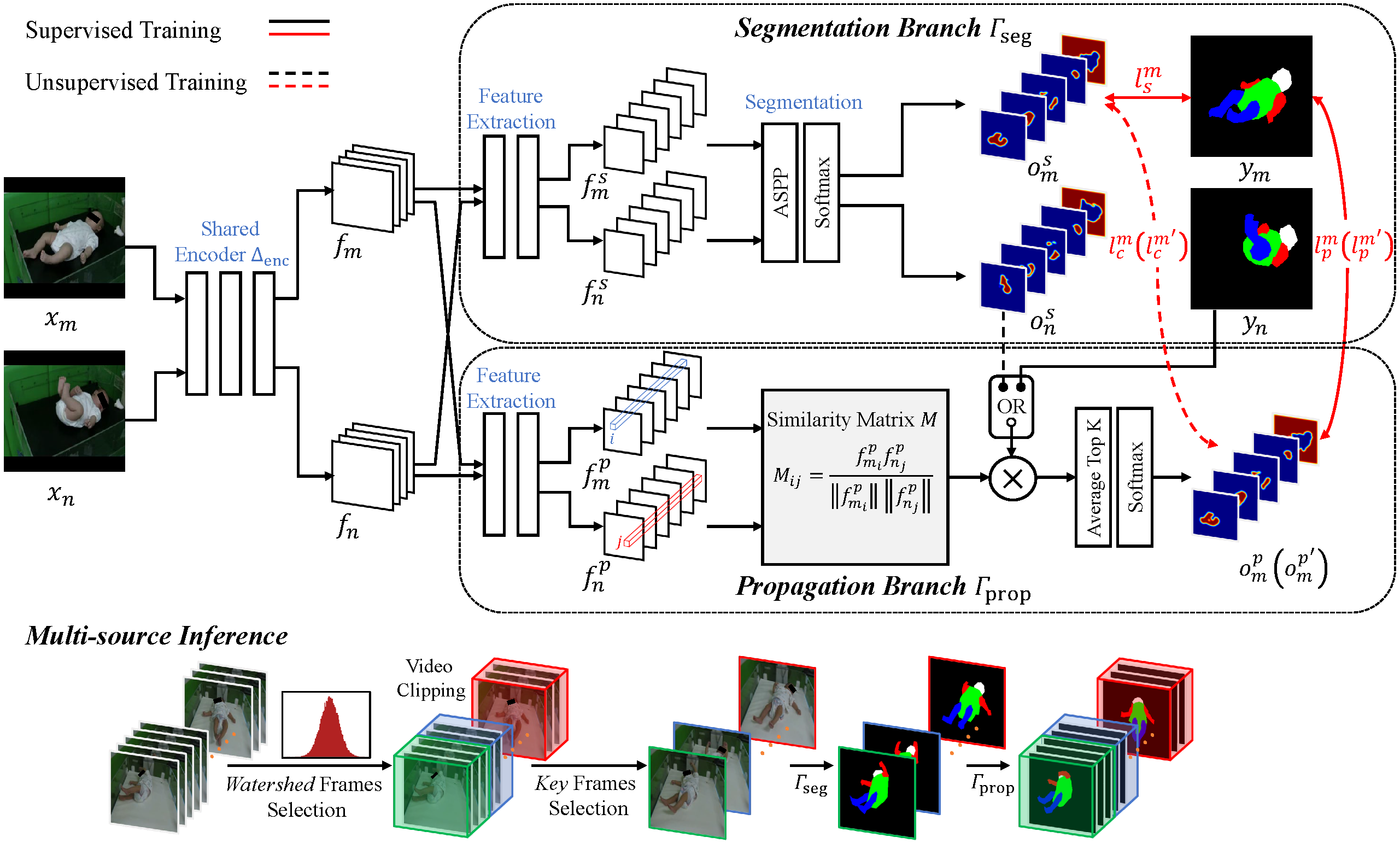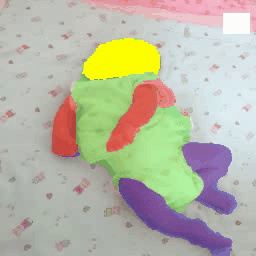SiamParseNet
The code implementation of our MICCAI20 paper SiamParseNet: Joint Body Parsing and Label Propagation in Infant Movement Videos .
You may be also interested in our follow-up work Semi-supervised Body Parsing and Pose Estimation for Enhancing Infant General Movement Assessment, which applied SiamParseNet to the real clinical settings and is publised on Medical Image Analysis 2023. We also release a infant body parsing video dataset in this follow-up work (dataset link).
Example Results
Dependencies
Python 3.7.10, Pytorch 1.10.2, etc.
Quick Start
Here we use a simple example to show how to train our model in full-supervised way.
# A toy example to show how to train SiamParseNet in a fully-supervised way
import os
import torch
from SPN.SPNet import SPNet, resnet_feature_layers
from ProUtils.misc import vl2ch, get_1x_lr_params, get_10x_lr_params, loss_calc, dist_loss_calc
import torch.optim as optim
# setting GPU
os.environ["CUDA_VISIBLE_DEVICES"] = "0"
# using fully-supervised SPN for training
model = SPNet()
model = model.cuda()
# finetuning from pretrained DeepLab is important for the training of SPN
# set use_finetune True once you set the path
# setting the path to pretrained DeepLab model
# which can be downloaded from
# https://drive.google.com/file/d/0BxhUwxvLPO7TVFJQU1dwbXhHdEk/view?resourcekey=0-7UxnHrm5eDCyvz2G35aKgA
use_finetune = False
if use_finetune:
pretrained_deeplab_path = ""
# load pretrained PropNet Model
saved_matnet_state_dict = torch.load(pretrained_deeplab_path)
for name, _ in model.CommonFeatureExtract.state_dict().items():
if "num_batches_tracked" in name.split('.'):
continue
ckpt_name = name.replace("model." + name.split('.')[1], "Scale." + resnet_feature_layers[int(name.split('.')[1])])
model.CommonFeatureExtract.state_dict()[name].copy_(saved_matnet_state_dict[ckpt_name])
for name, _ in model.MatFeatureExtract.state_dict().items():
if "num_batches_tracked" in name.split('.'):
continue
ckpt_name = name.replace("model.", "Scale.layer4.")
model.MatFeatureExtract.state_dict()[name].copy_(saved_matnet_state_dict[ckpt_name])
# load pretrained SegNet Model
saved_segnet_state_dict = torch.load(pretrained_deeplab_path)
for name, _ in model.SegFeatureExtract.state_dict().items():
if "num_batches_tracked" in name.split('.'):
continue
ckpt_name = name.replace("model", "Scale.layer4")
model.SegFeatureExtract.state_dict()[name].copy_(saved_segnet_state_dict[ckpt_name])
# freeze BN layers
for name, param in model.named_parameters():
if name.find('bn') != -1:
param.requires_grad = False
model.eval() # evaluation mode for BN layers
# setting learning rate
learning_rate = 2.5e-4
momentum = 0.9
weight_decay = 0.0005
optimizer = optim.SGD([{'params': get_1x_lr_params(model), 'lr': learning_rate},
{'params': get_10x_lr_params(model), 'lr': 10 * learning_rate}],
lr=learning_rate,
momentum=momentum,
weight_decay=weight_decay)
optimizer.zero_grad()
# setting x_m (src_img_batch) and x_n (tar_img_batch)
# size is (batch, channel, height, width)
src_img_batch = torch.rand((2, 3, 256, 256)).cuda()
tar_img_batch = torch.rand((2, 3, 256, 256)).cuda()
# setting y_m (src_lbl_batch) and y_n (tar_lbl_batch)
# size is (batch, height, width)
src_lbl_batch = torch.randint(high=5, size=(2, 256, 256)).cuda().to(dtype=torch.float32)
tar_lbl_batch = torch.randint(high=5, size=(2, 256, 256)).cuda().to(dtype=torch.float32)
# change to one-hot representation
# size is (batch, channel, height, width)
src_lbl_batch_resize = vl2ch(src_lbl_batch).cuda()
tar_lbl_batch_resize = vl2ch(tar_lbl_batch).cuda()
# One forward during training
# outputs are segmentation maps from segmentation branch (*_img_seg_lbl) and propagation branch (*_img_mat_lbl)
src_img_seg_lbl, tar_img_seg_lbl, src_img_mat_lbl, tar_img_mat_lbl = model(src_img_batch,
tar_img_batch,
src_lbl_batch_resize,
tar_lbl_batch_resize)
# we suggest to use class weight, here we set None for simplicity
# segmentation branch loss
src_seg_loss = loss_calc(src_img_seg_lbl, src_lbl_batch_resize, class_weight=None)
tar_seg_loss = loss_calc(tar_img_seg_lbl, tar_lbl_batch_resize, class_weight=None)
# propagation branch loss
src_mat_loss = loss_calc(src_img_mat_lbl, src_lbl_batch_resize, class_weight=None)
tar_mat_loss = loss_calc(tar_img_mat_lbl, tar_lbl_batch_resize, class_weight=None)
# consistency loss between two branches
src_loss = dist_loss_calc(src_img_seg_lbl, src_img_mat_lbl, class_weight=None)
tar_loss = dist_loss_calc(tar_img_seg_lbl, tar_img_mat_lbl, class_weight=None)
loss = src_seg_loss + tar_seg_loss + src_mat_loss + tar_mat_loss + src_loss + tar_loss
loss.backward()
optimizer.step()Our model can also be trained in a semi-supervised way. tr_type is set to 0, 1, 2 for unsupervised, semi-supervised, and fully-supervised cases, respectively.
# A toy example to show how to train SiamParseNet in a semi-supervised way
import os
import torch
from SPN.SPNet import SemiSPNet, resnet_feature_layers
from ProUtils.misc import vl2ch, get_1x_lr_params, get_10x_lr_params, loss_calc, dist_loss_calc
import torch.optim as optim
# setting GPU
os.environ["CUDA_VISIBLE_DEVICES"] = "0"
# using fully-supervised SPN for training
model = SemiSPNet()
model = model.cuda()
# finetuning from pretrained DeepLab is important for the training of SPN
# set use_finetune True once you set the path
# setting the path to pretrained DeepLab model
# which can be downloaded from
# https://drive.google.com/file/d/0BxhUwxvLPO7TVFJQU1dwbXhHdEk/view?resourcekey=0-7UxnHrm5eDCyvz2G35aKgA
use_finetune = False
if use_finetune:
pretrained_deeplab_path = ""
# load pretrained PropNet Model
saved_matnet_state_dict = torch.load(pretrained_deeplab_path)
for name, _ in model.CommonFeatureExtract.state_dict().items():
if "num_batches_tracked" in name.split('.'):
continue
ckpt_name = name.replace("model." + name.split('.')[1], "Scale." + resnet_feature_layers[int(name.split('.')[1])])
model.CommonFeatureExtract.state_dict()[name].copy_(saved_matnet_state_dict[ckpt_name])
for name, _ in model.MatFeatureExtract.state_dict().items():
if "num_batches_tracked" in name.split('.'):
continue
ckpt_name = name.replace("model.", "Scale.layer4.")
model.MatFeatureExtract.state_dict()[name].copy_(saved_matnet_state_dict[ckpt_name])
# load pretrained SegNet Model
saved_segnet_state_dict = torch.load(pretrained_deeplab_path)
for name, _ in model.SegFeatureExtract.state_dict().items():
if "num_batches_tracked" in name.split('.'):
continue
ckpt_name = name.replace("model", "Scale.layer4")
model.SegFeatureExtract.state_dict()[name].copy_(saved_segnet_state_dict[ckpt_name])
# freeze BN layers
for name, param in model.named_parameters():
if name.find('bn') != -1:
param.requires_grad = False
model.eval() # evaluation mode for BN layers
# setting learning rate
learning_rate = 2.5e-4
momentum = 0.9
weight_decay = 0.0005
optimizer = optim.SGD([{'params': get_1x_lr_params(model), 'lr': learning_rate},
{'params': get_10x_lr_params(model), 'lr': 10 * learning_rate}],
lr=learning_rate,
momentum=momentum,
weight_decay=weight_decay)
optimizer.zero_grad()
# setting x_m (src_img_batch) and x_n (tar_img_batch)
# size is (batch, channel, height, width)
src_img_batch = torch.rand((2, 3, 256, 256)).cuda()
tar_img_batch = torch.rand((2, 3, 256, 256)).cuda()
# setting y_m (src_lbl_batch) and y_n (tar_lbl_batch)
# size is (batch, height, width)
src_lbl_batch = torch.randint(high=5, size=(2, 256, 256)).cuda().to(dtype=torch.float32)
tar_lbl_batch = torch.randint(high=5, size=(2, 256, 256)).cuda().to(dtype=torch.float32)
# set training type
# 0: unsupervised, 1: semi-supervised, 2: supervised
# here we use 1: target image has label but source image doesn't have label
tr_type = 1
src_lbls = src_lbl_batch.cuda() if tr_type == 2 else None
tar_lbls = tar_lbl_batch.cuda() if tr_type != 0 else None
# change to one-hot representation
# size is (batch, channel, height, width)
src_lbl_batch_resize = vl2ch(src_lbl_batch).cuda() if tr_type == 2 else None
tar_lbl_batch_resize = vl2ch(tar_lbl_batch).cuda() if tr_type != 0 else None
# One forward during training
# outputs are segmentation maps from segmentation branch (*_img_seg_lbl) and propagation branch (*_img_mat_lbl)
src_img_seg_lbl, tar_img_seg_lbl, src_img_mat_lbl, tar_img_mat_lbl = model(src_img_batch,
tar_img_batch,
src_lbl_batch_resize,
tar_lbl_batch_resize,
tr_type)
# we suggest to use class weight, here we set None for simplicity
# segmentation branch loss
src_seg_loss = loss_calc(src_img_seg_lbl, src_lbl_batch_resize, class_weight=None) if tr_type == 2 else None
tar_seg_loss = loss_calc(tar_img_seg_lbl, tar_lbl_batch_resize, class_weight=None) if tr_type != 0 else None
# propagation branch loss
src_mat_loss = loss_calc(src_img_mat_lbl, src_lbl_batch_resize, class_weight=None) if tr_type == 2 else None
tar_mat_loss = loss_calc(tar_img_mat_lbl, tar_lbl_batch_resize, class_weight=None) if tr_type != 0 else None
# consistency loss between two branches
src_loss = dist_loss_calc(src_img_seg_lbl, src_img_mat_lbl, class_weight=None)
tar_loss = dist_loss_calc(tar_img_seg_lbl, tar_img_mat_lbl, class_weight=None)
if tr_type == 2:
loss = (src_seg_loss + tar_seg_loss + src_mat_loss + tar_mat_loss + src_loss + tar_loss)
if tr_type == 1:
loss = (tar_seg_loss + tar_mat_loss + src_loss + tar_loss)
if tr_type == 0:
loss = (src_loss + tar_loss)
loss.backward()
optimizer.step()DONE
The network structure of SiamParsetNet
The AAT training
TODO
MSI testing codes
Citing SiamParseNet
If you find our approaches useful in your research, please consider citing:
@inproceedings{ni2020siamparsenet,
title={SiamParseNet: Joint Body Parsing and Label Propagation in Infant Movement Videos},
author={Ni, Haomiao and Xue, Yuan and Zhang, Qian and Huang, Xiaolei},
booktitle={International Conference on Medical Image Computing and Computer-Assisted Intervention},
pages={396--405},
year={2020},
organization={Springer}
}
For any problems with the code, please feel free to open an issue or contact me: homerhm.ni@gmail.com
Acknowledgement
We acknowledge the code about DeepLab from speedinghzl.



